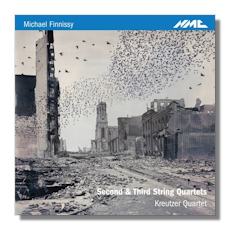
The Internet's Premier Classical Music Source
Related Links
- Finnissy Reviews
- Latest Reviews
- More Reviews
-
By Composer
-
Collections
DVD & Blu-ray
Books
Concert Reviews
Articles/Interviews
Software
Audio
Search Amazon
Recommended Links
Site News
 CD Review
CD Review
Michael Finnissy

- Second String Quartet
- Third String Quartet
Kreutzer Quartet
NMC D180
This is the second CD by the Kreutzer Quartet of works by Michael Finnissy, who was born in 1946. (The first on Metier MSV92011 featured works using two violins, viola and cello but only the composer's first actual string quartet – in that form.) The second and third string quartets (expertly, convincingly and very beautifully played on this CD from NMC) have their origins in the middle of the last decade (2006 to 2009) and were conceived at roughly the same time, although in fact what is now the Third was planned first.
The Third is over twice as long as the Second (at 44 and 19 minutes respectively). In common with other works by Finnissy, it overtly acknowledges the inspiration (not exactly the influence) of other composers. In this case Bruckner… Finnissy recalls hearing his Ninth Symphony at a Promenade Concert in the early 1960s. And indeed the scale, the use of slowly-developing musical blocks and of gently shifting tonalities, pervade the Third String Quartet. Structure is vital. It's a structure organized according to numbers represented by the work's dedicatee, Amanda Bayley. Like Bruckner's music, this is at its heartiest when slow. And tinged with tragedy. And grand – if not grandiose.
Both the Second and Third String quartets combine tonality and atonality in a highly convincing and purposeful way. As might be expected from such a juxtaposition, there is explicit (yet never intrusive) exploration of the form of the (string) quartet itself… counterplay between sustained and staccato notes and passages, exposure of the instruments' sonic properties, delight from the combinations of string tessiture, sensitivity to the possibilities of subdued virtuosity and so on.
The Kreuzers are alive and alert to these aspects of the music in every way. Though they never linger or over-emphasize this aspect of Finnissy's writing. Their purpose is to play the music for communication's sake. Indeed, if anything, their tempi might seem just a tiny bit too "businesslike": the music is so beautiful, its sound world so convincing, that a caress here and there might have enhanced it. A sense might also have worked that the many aspects of thematic development could have been given even more room to examine themselves.
Just as Schoenberg's Second String Quartet introduced the voice as it shifted into atonality, so Finnissy's Third introduces a surprising element at about a third of the way through: brief, unobtrusive snatches of recorded birdsong. Other material in the piece is actually transcriptions of the same. This addition works very well. At certain moments it's the strings which intrude on the extreme naturalness of the birds – actually recorded by the composer early in the morning near his home. They also make a telling contrast to the massive sonorities of Bruckner.
But neither the Third nor the much less expansive – though every bit as compelling and enjoyable – Second String Quartet sounds particularly experimental, or forced. For all the atonality and pre-occupation with structure and use of number, for all the allusions to Haydn as well as Bruckner, for all the care and respect for tradition that Finnissy brought to the compositional process (the Second is notated as a series of parts rather than a conventional score), this is accessible, memorable and highly enjoyable music.
The Kreuzers have its measure in every way. Their playing blends spontaneity with rigor, verve with a deft technique – above all a very musical sympathy for the composer's intentions and achievements. The changes from flowing to almost stuttering music towards the end of the Third Quartet with long pauses are surely very demanding, for example. The two acoustics (London churches) chosen for the recordings are clear; they aid our appreciation of the music. The booklet gives useful background information on works, composer and players. This is the only recording of these works, of course. Even if your interest in small scale contemporary string music is developing – and certainly if you already find Finnissy's style appealing, you need not hesitate to buy this excellent coupling. It is likely to leave you wanting more.
Copyright © 2012, Mark Sealey.





















